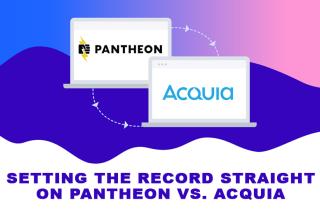Drupal's principles and objectives are centered on web accessibility, with the online accessibility program advancing significantly through Drupal 9 and Drupal 10. Understanding the importance of website accessibility and how Drupal 9 and Drupal 10 ensure it is crucial is essential.
Originally designed to fulfil the need for automatic information exchange between scientists at research institutes and universities worldwide, the internet is now a vital component of the lives of almost 3 billion people. The internet is perhaps the most powerful resource available to humans today, used for everything from social networking to project information gathering.
AI chatbots and machine learning apps have become increasingly popular, leading organizations to establish online presences and enhance customer experience through websites. This trend is expected as chat has replaced social networking as the primary method for business communication.
But have you ever stopped to think, can everyone access the web?
In 2018, web accessibility remains less accessible due to the competitive market pushing businesses to reach as many people as possible. The concept behind web accessibility is to eliminate barriers that the audience faces, thereby increasing the chances of reaching potential customers.

What is Web Accessibility?
Web accessibility is a broad term that includes those with normal vision, such as those who can see the screen on a sunny day, as well as screen readers and people with visual impairments.
The World Wide Web Consortium (WCAG) has established guidelines for websites to ensure their usefulness, with WCAG 2.0 being the widely recognized benchmark for online accessibility and user information. Originally published in 1999 as version 1.0 and again in 2008 as version 2.0, it ensures the highest level of accessibility.
The consequences of ignoring accessibility
Businesses that give website accessibility issues low priority or disregard them run the danger of suffering from a long range of adverse effects.
Legal challenges
From a moral duty to a legislative imperative, the push for an easier-to-use internet has changed. According to accessibility.com, in reality, there were 14.3% more web accessibility lawsuits filed in US courts in 2021 than there were in 2020.
Lawsuits are also anticipated in the future. In response, the US Department of Justice proposed a rule that would have made WCAG 2.0 Level AA a fair criterion for accessibility, but it later retracted that proposal.
In addition to the US, the UK enacted a law in 2018 mandating that "reasonable adjustments" for handicapped individuals be taken into account by all UK service providers. Every website owned by the public sector must comply with the global WCAG 2.1 AA accessibility standards. Businesses that violate these rules could be penalized.
Weakened brand reputation
Businesses that neglect website accessibility risk being perceived as exclusionary, a negative association that no other organization wants to be associated with. The World Economic Forum study revealed that a company's reputation directly influences over 25% of its market value.
The public's growing sensitivity to diversity, equality, and inclusion (DE&I) issues—especially among Gen Z and Millennials—has raised the stakes recently. It is a company's greatest advantage to acknowledge this paradigm shift and implement programs that promote DE&I everywhere. Equality and inclusion also apply to websites; it is not sufficient to hire more diverse applicants or to briefly display a rainbow-colored logo during Pride Month.
Lost market share and revenue
One billion individuals, or 15% of the global population, are estimated to be disabled, according to the World Bank Group. The Centres for Disease Control and Prevention estimates that 25.5% of people self-identify as disabled in the United States alone.
According to the Institute for Educational Leadership, companies with substantial discretionary income and purchasing power—nearly half a trillion dollars—run the danger of losing customers and market share. 98% of website homepage are unavailable, costing UK businesses almost two billion pounds a month, according to a 2019 WebAIM analysis. 71% of impaired users also stop visiting websites that are inaccessible.
A clear business case for website accessibility
To prevent losses and guarantee a positive client experience, businesses need to make sure their digital sites adhere to international standards. According to a Great CX for everyone research, 85% of firms suffer when they fail to accommodate customers who require digital access. The primary motivation behind accessibility initiatives is the benefits of usability. If accessible experiences are not provided, there may be monetary losses, long-term harm to a brand's reputation, user alienation, and lost income. For inclusive design to be successful, accessible products must be acknowledged as essential.
Prioritizing exclusivity allows brands to reach a wider audience and increase their market share, including adolescent consumers, non-native speakers, older adults, and those with disabilities. This strategy, called the curb-cut effect, benefits everyone—from customers to first-time bike riders to recuperating hospital patients. Enhancing a website's accessibility may benefit businesses in more ways than one, enabling them to serve a broader spectrum of consumers.
Here are a few ways that inclusive web design helps businesses expand their reach and better serve customers:
Search engines will find your site(s) more readily if you incorporate non-visible site elements like alt text descriptions and descriptive language for rich media assets. Code that is simplified as a result of accessible website design frequently speeds up page loads and uses less bandwidth. Mobile users and those viewing pages in low lighting can see content more easily when it has higher colour contrasts and standard fonts.
Digital leaders recognize that a variety of requirements and tastes exist throughout the online community, and that their websites should cater to these differences. From a platform perspective, this is the reason Drupal is dedicated to providing businesses with the features and resources they require to build more inclusive digital experiences. So, let's not forget that an organization needs the appropriate partners and resources in order to provide accessible digital experiences.
How Drupal prioritizes digital accessibility
Enhancing website accessibility was a primary focus when Drupal 8 was first published in 2015. The Web Accessibility Initiative - Accessible Rich Internet Applications (WAI-ARIA) is a set of technical guidelines developed by the World Wide Web Consortium to make websites accessible to people with disabilities. It is currently included in Drupal core. Building and launching barrier-free websites that comply with online rules is now easier than ever thanks to the inclusion of these criteria directly in Drupal core. Developers don't have to spend a lot of time or money retroactively equipping their websites with accessible components because they can leverage WAI-ARIA features from the moment of install. Drupal 8.8 comes with the Claro administrative theme, which offers a simpler, more user-friendly interface for authoring, setting, and site management.

Other improved web accessibility features that Drupal 8 introduced include:
- Aural alerts
- Control tab order
- Field sets and details
- Required alt text
- Improved colour scheme, font sizes, and mobile responsiveness features
Enhancing accessibility was the main objective for Drupal 9. As an illustration, the core of Drupal has been largely modernized and offers an inclusive user experience straight out of the box. Additional improvements incorporated include:
- An inclusive front-end design that reflects current and future CMS standards.
- Additional functionality that supports new features, such as second-level navigation, embedded media, layout builder, and other UX improvements.
- A totally WCAG AA-compliant theme
The goal of creating a more fantastic, inclusive, and open web experience is always changing, and the Drupal community is dedicated to spearheading this effort. Go here to discover more about the advantages of Drupal and how to use it to optimize digital experiences.



